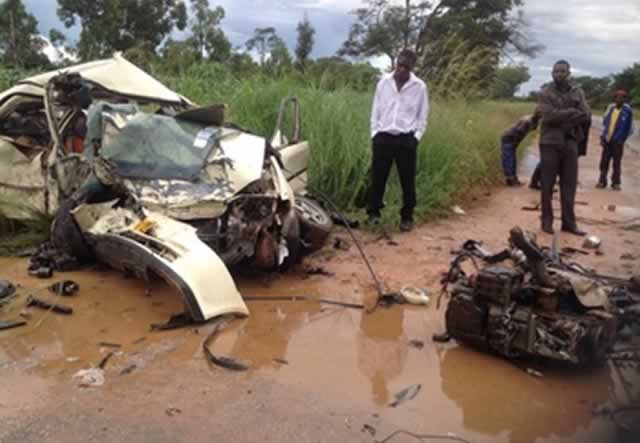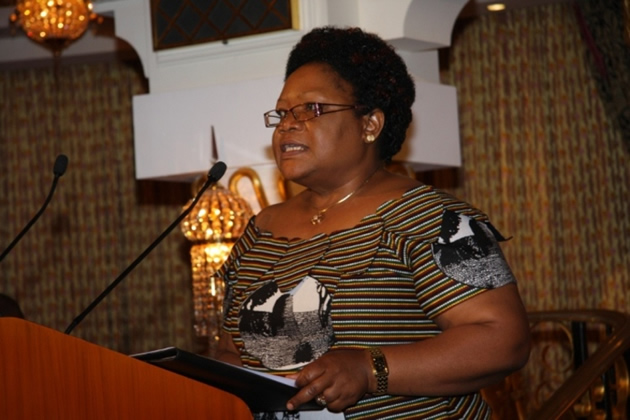30 Easter RTA deaths is 30 too many!


Five people died on the spot while two others were critically injured when a Mitsubishi Lancer collided head-on with a VW Bora near Banket along the Harare-Chirundu Highway yesterday.— (Picture by Isdore Guvamombe)
Gerald Maguranyanga Traffic Friday
THE appalling death toll from the 2014 Easter and Independence holidays in Zimbabwe confirms 30 victims. In 2013, a staggering 50 people lost their lives during the same period. In 2012 the calamity was “better” at 23, according to official information released by Chief Superintendent Paul Nyathi. Before we celebrate the “improvement” on the 2013 figures, let’s explore how others fared, in a simple compare-and-contrast.
With the foreign 2014 figures not yet available, the 2013 Easter road traffic accident (RTA) deaths for Zambia were 17 (Zambian Police) and just three for New Zealand (anzpaa.org). South Africa, which suffers the ignominy of one of the deadliest accident rates in the world, tipped the gory scales at 241 dead (iol Motoring). For those that loudly advocate road dualisation as the panacea for our profuse carnage, South Africa clearly disproves that armchair theory. Mzansi enjoys what is largely a world-class road network, but she grieves terribly from an out-of-control RTA bloodbath that slaughters a truly astonishing 14 000 souls annually.
The bothersome question is: “Why do so many die on Zimbabwean roads each holiday period?” In fact, holiday or no holiday, the average daily RTA death rate in Zimbabwe is an unbearable five people. Make that a traffic death every five hours! That figure is unacceptable, for a nation of only 13 million people.
One Robert Muganda, writing after being outraged by the Easter deaths last year, was blatant: “With the way things are unfolding, it is likely that most drivers on our roads, both new and old, are actually terrible, insane and suicidal!”
A hard-hitting Herald editorial from the same period is pointblank: “There is an incredible (official) tolerance in Zimbabwe, despite the appalling loss of life on our roads and the destruction of property, (we are) over-allowing criminals to drive around killing people … This tolerance must end.” The editorial laments: “It can be safely said that if all road laws in Zimbabwe were rigidly enforced, then maybe around 20 people only a year would die…”
Do our political leaders grasp the clear urgency in the matter? Surely, if the authorities adopted a hardline approach, then we would not be talking of such dreadful deaths. Why the business-as-usual attitude when there is so much poor discipline by drivers, cyclists and pedestrians?
Fuelling the woes is the dishonest traffic cop who pockets a few dollars and turns a blind eye to non-compliance, abetting deadly accidents in the process.
Kombis dangerously cut other motorists as a matter of course. EVERY kombi overloads and most drivers bribe their way past police checkpoints and also have inadequate driving documentation. They have lately developed the sick habit of brazenly overtaking in front of oncoming traffic.
Though many of us express uneasiness at the poor road condition, the truth is, most highways remain reasonably driveable and are rarely cited as the explicit cause of any accident. The killer accident on Easter eve on the Harare-Bindura highway that took four people had nothing to do with bad roads. Six people perished in Nyanga last week when their speeding bus overturned; that too had nothing to do with a poor road.
In virtually all the recorded Easter accidents, preliminary police indications indict sheer recklessness. The only reason drink-driving is not a huge factor is because our incapacitated police have not been rigorously testing for DUI (driving under the influence). The absurd official tolerance has allowed driving criminals to thrive on the roads. Drunks gleefully party as they drive! Ko kutyei?
Many kombis on the road sport a reprehensible smashed-up windscreen; shattered by you-know-who! Strangely, the police tolerate a smashed-up windscreen kombi, allowing it to operate normally and even pass through unmolested at a police checkpoint? Of course, a smashed-up windscreen is a grave danger to its passengers.
In Zimbabwe, a driver’s licence permits a private motorist to drive unimpeded for the next half century, or more! One may acquire their licence at 16 and still use it to drive at 80. No expiry. No mandatory retesting. No forced eye examination. No refresher course. No nothing.
The aviation industry is so safe today because it demands an astonishing raft of strict re-testing measures regularly. Certain medical examinations for pilots become due within six months. No matter how fantastic a captain you maybe, unfavourable medical results will ground you!
In Zimbabwe, it was time we adopted and rigorously enforced drastic driving measures. The usual half-hearted measures have failed.
Our statutes do not help much either. Some traffic penalties are as low as US$5. It’s a slap on the wrist for potentially deadly offences. It seems for the foreseeable future, we will endure the heartache of the wanton disregard for life.
To be honest, in the eyes of critical observers, officialdom has little regard for precious life. Critics may be justified to label us the Dark Continent.
Madness is defined as doing the same thing over and over again but expecting (better) results. South Africa and Zimbabwe enjoy the same road policing insanity. Our RTA numbers have hit the roof and here we are, employing unrefined methods from decades ago, chief of which is the much-hated static roadblock. Where is the Penalty Points System, promised over the years by various authorities? It beggars belief that Zimbabwe, much like South Africa, believes so much in being “out in full force” at a static road- block; in spite of that partial method wholly failing to stop the carnage in both countries.
In my opinion, ingenuity is missing from the Ministry of Transport and the Police. Varume nevakadzi vasina action! I am dismayed that a critical oversight component called the Parliamentary Portfolio Committee on Transport has been noiseless, like it did not exist. The quietness exposes no political commitment.
The Global Status Report on Road Safety 2013 indicates that worldwide, only 28 nations instituted comprehensive road safety laws on five key risk factors: drink-driving, speeding, failing to use motorcycle helmets, seatbelts and child restraints. Of course, we are not part of the serious 28. We are African! Consequently, many will continue to die on our roads on a daily basis.
Next week, Traffic Friday will generate a frank scorecard on Senior Assistant Commissioner Felie Mujanga. She is the fresh leader of ZRP National Traffic. Her fundamental responsibility is policing road traffic, ensuring everyone’s safety.
The good lady has been a 100-plus days in charge now. Is she doing a good job? Does she inspire confidence going forward? Does she have spine-enough to exorcise the killer Zimbabwean road traffic demon, and rein-in her essentially corrupt traffic cops? Traffic Friday will certainly be frank-and-fair with her!
Holidays or no holidays, let’s keep the driving “happy, happy!”
Gerald Maguranyanga moderates Road Safety Africa, on www.facebook.com/RoadSafetyAfrica, an interactive community page that solicits ideas to curb road traffic accidents in Zimbabwe and Africa. Feedback: WhatsApp only please: +263 772 205 300.









Comments